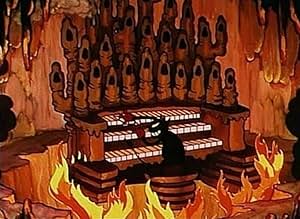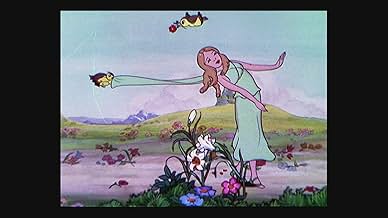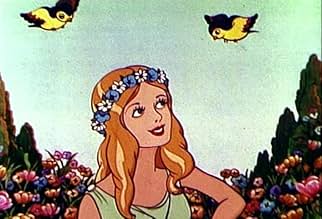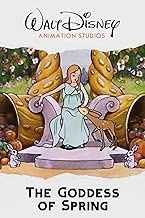CALIFICACIÓN DE IMDb
6.6/10
1.6 k
TU CALIFICACIÓN
Agrega una trama en tu idiomaThe lovely goddess of spring, Persephone, is kidnapped by Hades, thus bringing about the winter season.The lovely goddess of spring, Persephone, is kidnapped by Hades, thus bringing about the winter season.The lovely goddess of spring, Persephone, is kidnapped by Hades, thus bringing about the winter season.
- Dirección
- Guionista
- Elenco
Kenny Baker
- Singing Narrator
- (voz)
- (sin créditos)
Jessica Dragonette
- Goddess of Spring
- (voz)
- (sin créditos)
Tudor Williams
- Pluto
- (voz)
- (sin créditos)
- Dirección
- Guionista
- Todo el elenco y el equipo
- Producción, taquilla y más en IMDbPro
Opiniones destacadas
PiThis is obviously the story of Hades and Persephone. As the beauty of summer gives way to winter, she is forced to live underground in a sort of hell. There's more to the story, but suffice it to say that this was an explanation for the change of seasons. Spring is a beautiful young woman and Hades is the stereotypical devil (not really the Greek entity). His operatic voice is stunning and his pleasing must be fore eternity. She is always going tor return.
This entry in the Silly Symphonies adapts the story of Persephone (Proserpina in Latin). "The Goddess of Spring" depicts the title character in an idealistic setting until Hades (Pluto in Latin) kidnaps her. Since she can't be happy in Hell, they have to reach a settlement.
Obviously this is a loose adaptation. As in Disney's "Hercules", Hades gets depicted as a rendering of Satan; in Greek mythology, the underworld had no relation to the modern understanding of Hell.
It's an okay cartoon. I've always been more partial to Warner Bros.'s cartoons, since they had an irreverent side (in contrast to Disney's "nice" cartoons). Jessica Dragonette (the goddess) also voiced Princess Glory in Fleischer Studios' "Gulliver's Travels". Kenny Baker (the narrator) is not to be confused with the actor who played R2D2.
Obviously this is a loose adaptation. As in Disney's "Hercules", Hades gets depicted as a rendering of Satan; in Greek mythology, the underworld had no relation to the modern understanding of Hell.
It's an okay cartoon. I've always been more partial to Warner Bros.'s cartoons, since they had an irreverent side (in contrast to Disney's "nice" cartoons). Jessica Dragonette (the goddess) also voiced Princess Glory in Fleischer Studios' "Gulliver's Travels". Kenny Baker (the narrator) is not to be confused with the actor who played R2D2.
As the Snow White Platinum DVD notes, The Goddess of Spring served mostly as practice for the Disney animators on how to properly animate humans for Snow White & the Seven Dwarfs. Not only did they improve on animating humans, I thought they also greatly improved on drawing backgrounds, animals, and the dwarf-like creatures that appeared in The Goddess of Spring. While The Goddess of Spring is an animated short with a much smaller budget, the difference between the dwarfs in this cartoon and Snow White are as different as night and day. The dwarfs in Goddess of Spring were all drawn the same with no unique personalities, whereas Snow White's dwarfs are all unique in both appearance and personality.
I've also read that people were impressed with how well the hell sequences were drawn in Goddess of Spring. I have to admit that I wasn't really impressed when I saw it. I thought the sequences were too bland and a little too bright for a depiction of hell. I was actually more impressed with the hell sequences drawn in 1929's Hell's Bells, one of the first, rare Silly Symphonies drawn by Ub Iwerks.
However, I will say that I did somewhat enjoy the story of Goddess of Spring, which uses mythology to explain why we don't have everlasting spring. The opera style was kind of corny though. I just didn't get the sense that Disney animators concentrated too much on this short, but rather just as practice for Snow White. Nevertheless, I guess Goddess of Spring fulfilled its mission, because Snow White is one of the greatest, most landmark films in the history of cinema.
My IMDb Rating: 5/10
I've also read that people were impressed with how well the hell sequences were drawn in Goddess of Spring. I have to admit that I wasn't really impressed when I saw it. I thought the sequences were too bland and a little too bright for a depiction of hell. I was actually more impressed with the hell sequences drawn in 1929's Hell's Bells, one of the first, rare Silly Symphonies drawn by Ub Iwerks.
However, I will say that I did somewhat enjoy the story of Goddess of Spring, which uses mythology to explain why we don't have everlasting spring. The opera style was kind of corny though. I just didn't get the sense that Disney animators concentrated too much on this short, but rather just as practice for Snow White. Nevertheless, I guess Goddess of Spring fulfilled its mission, because Snow White is one of the greatest, most landmark films in the history of cinema.
My IMDb Rating: 5/10
A Walt Disney SILLY SYMPHONY Cartoon Short.
Persephone, THE GODDESS OF SPRING, is kidnapped by Hades, the devilish god of the Underworld, leaving the earth in perpetual winter. Will the warmth & joy of Spring ever return?
A vivid, and somewhat bizarre, little film which retells the story from Greek Mythology, while incorporating both operatic & jazz traditions. The animators seem to have confused the character of Hades with that of the Biblical Satan. Years later, Walt would draw comparison between Persephone & Snow White, to illustrate how far his animators evolved in just three short years.
The SILLY SYMPHONIES, which Walt Disney produced for a ten year period beginning in 1929, are among the most fascinating of all animated series. Unlike the Mickey Mouse cartoons in which action was paramount, with the Symphonies the action was made to fit the music. There was little plot in the early Symphonies, which featured lively inanimate objects and anthropomorphic plants & animals, all moving frantically to the soundtrack. Gradually, however, the Symphonies became the school where Walt's animators learned to work with color and began to experiment with plot, characterization & photographic special effects. The pages of Fable & Fairy Tale, Myth & Mother Goose were all mined to provide story lines and even Hollywood's musicals & celebrities were effectively spoofed. It was from this rich soil that Disney's feature-length animation was to spring. In 1939, with SNOW WHITE successfully behind him and PINOCCHIO & FANTASIA on the near horizon, Walt phased out the SILLY SYMPHONIES; they had run their course & served their purpose.
Persephone, THE GODDESS OF SPRING, is kidnapped by Hades, the devilish god of the Underworld, leaving the earth in perpetual winter. Will the warmth & joy of Spring ever return?
A vivid, and somewhat bizarre, little film which retells the story from Greek Mythology, while incorporating both operatic & jazz traditions. The animators seem to have confused the character of Hades with that of the Biblical Satan. Years later, Walt would draw comparison between Persephone & Snow White, to illustrate how far his animators evolved in just three short years.
The SILLY SYMPHONIES, which Walt Disney produced for a ten year period beginning in 1929, are among the most fascinating of all animated series. Unlike the Mickey Mouse cartoons in which action was paramount, with the Symphonies the action was made to fit the music. There was little plot in the early Symphonies, which featured lively inanimate objects and anthropomorphic plants & animals, all moving frantically to the soundtrack. Gradually, however, the Symphonies became the school where Walt's animators learned to work with color and began to experiment with plot, characterization & photographic special effects. The pages of Fable & Fairy Tale, Myth & Mother Goose were all mined to provide story lines and even Hollywood's musicals & celebrities were effectively spoofed. It was from this rich soil that Disney's feature-length animation was to spring. In 1939, with SNOW WHITE successfully behind him and PINOCCHIO & FANTASIA on the near horizon, Walt phased out the SILLY SYMPHONIES; they had run their course & served their purpose.
While charming on its own merits, this short really shows how far the Disney animators came in the three years between this and Snow White and the Seven Dwarfs. The movements of the leading lady of The Goddess of Spring are awkward and somewhat grotesque; her limbs seem to flail about as she skips to her throne, and she does not seem to possess any bones or weight at all. As Frank Thomas and Ollie Johnston said in their book "The Illusion of Life", there was no way she would have ever been able to carry an animated film.
But like I said, the short is cute. It's a decent retelling of Greek myth; it excludes Persephone's mother Demeter from the tale, but this is understandable as the story has to be compressed to keep a ten minute running time. Some of the music is in the operetta style, which I'm not too keen on, but there's a cool jazz number in the first underworld scene, where Hades' demons sing of "Mighty Hades". Overall, if you're an animation buff you're more likely to enjoy this than the casual viewer; while there is some entertainment value here, its mainly of historical interest only.
But like I said, the short is cute. It's a decent retelling of Greek myth; it excludes Persephone's mother Demeter from the tale, but this is understandable as the story has to be compressed to keep a ten minute running time. Some of the music is in the operetta style, which I'm not too keen on, but there's a cool jazz number in the first underworld scene, where Hades' demons sing of "Mighty Hades". Overall, if you're an animation buff you're more likely to enjoy this than the casual viewer; while there is some entertainment value here, its mainly of historical interest only.
¿Sabías que…?
- TriviaWalt Disney and his animators used this short as a test to see if they could create realistic animation, a style they would later perfect in Blanca Nieves y los siete enanos (1937).
Selecciones populares
Inicia sesión para calificar y agrega a la lista de videos para obtener recomendaciones personalizadas
Detalles
- Fecha de lanzamiento
- País de origen
- Sitio oficial
- Idioma
- También se conoce como
- A Greek Myth
- Productora
- Ver más créditos de la compañía en IMDbPro
- Tiempo de ejecución
- 10min
- Relación de aspecto
- 1.37 : 1
Contribuir a esta página
Sugiere una edición o agrega el contenido que falta





















